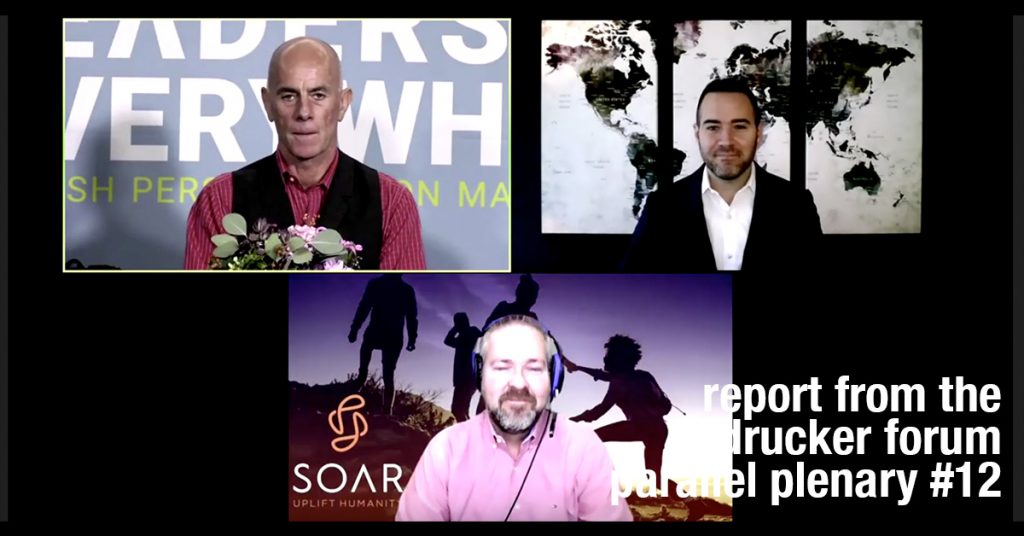
Moderator Tina Deutsch Co-Founder and Managing Partner, Haufe Advisory
Speakers
Paul Allen Founder, Ancestry.com, SOAR.com
Jon Clifton Global Managing Partner, Gallup
Bart Weetjens Social entrepreneur; Zen priest
Thomas Bubendorfer Solo climber and author
Leaders do damage to their organizations if they don’t do development of themselves. Their own capabilities to lead effectively are never perfect, and any investment they make in honing their skills has immediate payoff. How should leaders approach this responsibility in a disciplined way? How can they know if they’re improving?
Drucker Forum 2020
Each panellist had their own take on the topic. This report aims to join the dots between their separate viewpoints.
The scene was set: It all starts within. Bad leaders damage organisations, as they tend to be reactive, and make too many decisions under uncertainty. In leaving no time for themselves they have no opportunity for self reflection and growth. There is often a view that everything is too much but nothing works without me. There is no time, and more of the same is the only solution. Leaders are in a perpetual state of triage.
The annual Gallup poll tells us that only 13% of team members are actively engaged with their work. Most solutions to this problem are top-down and do not involve the senior management in implementation. Hence, they fail on two fronts: firstly, time is not taken to understand individual concerns, and secondly, this assumes that it is a problem which can be solved, which clearly it is not. It is a tension, so needs constant management.
ELEMENTS
There are five elements inherent in our leadership psyche: body, emotion, mind, spirit (purpose), and social – the last being of greater relevance in these difficult times.
It was argued that a healthy body begets a healthy mind, but it begs the question: how is this recognised? That must come from some dissatisfaction, and hence an emotion, which engages the mind to find a solution which may involve better physical results. These are substantial – we are not designed for our sedentary life (‘sitting is the new smoking’, to quote Bart Weetjens). Our creativity improves by 40% if we are moving in an urban setting and up to 60 % in a natural environment. There are plenty of studies to support this.
Changing one of the five elements has benefits for the others, and leads to improved performance. The HBR article ‘The Making of a Corporate Athlete’ was quoted. Helping colleagues to invest in improving their physical health was seen as a good thing and easily sold to colleagues, but with an unfortunate connotation: human is an investment and needs to yield 100% for business to thrive. That mechanical view of employment went unchallenged, at least by the panellists.
Dealing with emotions can also be challenging for a leader. Again, improving physicality can often lead to a calmer attitude and a realisation that individual purpose is not entirely tied to corporate performance. A better life-work balance can be achieved by doing the same in less time. Does this work for leaders only, or should this more relaxed attitude permeate the organisation? While that would be a good thing, it relies heavily on the leader’s new perceptions changing culture, which tends to be slow to trickle right through the business.
SOLUTIONS
Uncertainty scares us. Action removes the fear. The uncertainty of what to do before a proposed action means that most mental energy is exhausted before action, inhibiting decision making and time management. Many leaders have, or think they have, no time to do what is obvious to them, which is take time to think. That creates more stress.
Leaders need to create space for time to think. Their assumption is often wrong – often things work better without them. Importantly, the assumption remains untested.
The Gallup survey tells us that a B-level manager surrounds him- or herself with C managers, while an A+ manager chooses A++ managers. As an indicator of management strength, that is compelling. We all know that doing what a leader is good at and leaving other tasks to those more able to deal with them is a strong indicator of a good leader who then has thinking time.
The bottom line: identify more of what you do well, and do less of what you don’t do well.
Essentially, the ‘how’ is to get help. Employ a coach. Don’t worry too much about whether it’s a life coach or a business coach. Each does some of both. Use Paul Allen’s tip – do a chemistry session. Find out who you get on with. It’s about gaining back little bits of time so that the business leader can start to find a few minutes here and there to reflect and then start to make changes. It’s a snowball effect – there’s no silver bullet or quick fix. Stop looking for them. Start making lifelong changes.
Full disclosure – panellists were coaches or led coaching organisations. But they are still correct. It was fairly apparent to everyone what the issue was and what a solution might be. Getting leaders to acknowledge and find ways to act on that realisation could form the subject of a useful follow-up panel in the future.
About the Author:
Nick Hixson is an entrepreneur, business enabler based in the South of England, and Drucker Associate
This article is one in the “shape the debate” series relating to the fully digital 12th Global Peter Drucker Forum, under the theme “Leadership Everywhere” on October 28, 29 & 30, 2020.
#DruckerForum

